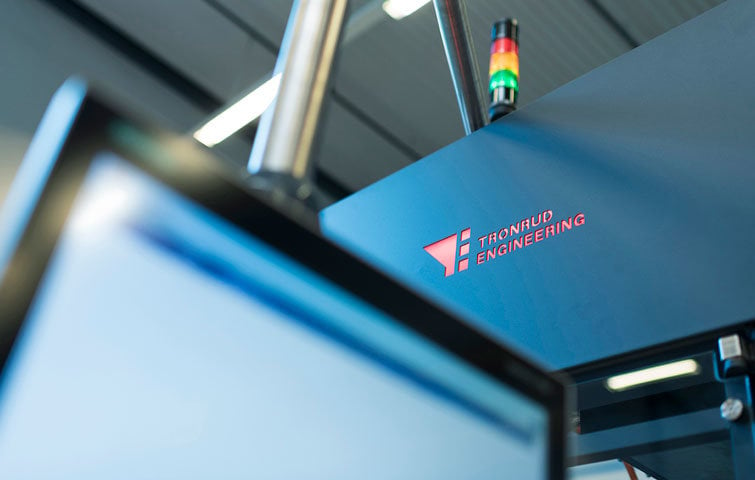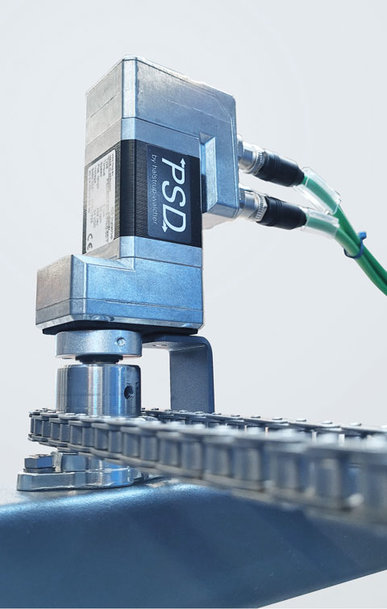www.ptreview.co.uk
03
'21
Written on Modified on
HOW TO PACK BAGS OF CRISPS WITH A FULLY AUTOMATIC CASE PACKER
During lockdown, we all spent a lot of time on the couch and some of us have gained a few pounds. But, when you open your crunchy bag of potato chips in the evening, have you ever stopped to think how many high-tech machines are involved in its production these days? The journey from potato to supermarket is a fascinating odyssey that involves a wide range of manufacturing and packaging machines. A host of machine builders are involved in developing and supplying specialist solutions for every step in the processing and packaging of foodstuffs. One of them is Tronrud Engineering from Eggemoen, near Oslo, in Norway. The company, which employs around 200 staff, supplies its customers with impressive, state-of-the-art packaging machines. Kjell Erik Meier is responsible for programming and automation of the machines at Tronrud. The TCP PN8 case packer is one of this high-tech machines.

TCP PN 8 – A fully automatic case packer
The TCP PN 8 is a secondary packaging machine that sorts bags and pouches and packs them into cases. The bags can contain anything from chips and nachos to coffee, lettuce or vegetables – anything that is not liquid. Food companies can integrate this machine downstream from their various primary packaging machines. The products are then packed into different cases for handling in further logistics processes. Well-known customers, such as multinational food and snack suppliers, use Tronrud Engineering machines world-wide for this purpose. For example, it also uses the TCP PN 8 to pack bags and pouches in cases in Russia, Turkey, Egypt and South Africa. Kjell Erik Meier:
“Depending on the settings, the machine can pack up to 160 bags into a case per minute – and fill up to 12 cases per minute. The benefits to our customers are clear.”
However, the machine also offers other advantages. Every movement the machine makes is actuated by electric motors. As a result, the machine has no pneumatic adjustment axes and is much more efficient than comparable machines with pneumatic drives. By using the latest control and servo technology, the solution can also take advantage of advances in digitisation, e.g. the status of the machine can be read out at all times – even remotely.
In addition to the industry-standard PackML machine language and IIOT functions, automatic format changeover is another highly desirable feature of modern packaging machines. This is because it allows the entire machine and its various processing modules to be adjusted from one case format to another extremely quickly.
Format changeover to different case sizes
Format changeover in the packaging machine may involve altering, e.g. the heights of conveyor belts or the width of the gap between two feed belts – to precisely the dimensions required by the bag of potato chips being transported to the case via these belts. The stops used to arrange the bags in the correct pattern also need to be adjusted depending on the sizes of the various cases. These are filled in several layers according to this pattern. When the first layer is arranged correctly, the bags are slid into the box. The first layer is then compressed in the case. The next layer of bags is then aligned and loaded on top. The modules required for this task must also be adjusted when the box dimensions and pattern of the bags change.
At the back of the TCP PN 8, there is a magazine from which the cases are erected. They are folded, glued and transported to the point where they will be filled with bags. This module is integrated into the machine and also has different height and width adjustments – specific to the case format.
Tronrud has automated most of these adjustments. As a result, the machine can switch from one pre-set case format to another at the touch of a button. For safety reasons, there are only a few settings that require manual adjustment via the control knobs on the external feeds of the machine. Kjell Erik Meier explains the advantages of this level of automation:
“Automating the adjustment of the total of 10 machine axes enables our customers to save 10 minutes per format changeover compared to a machine with manual adjustment. In terms of bags, this is the equivalent of up to 1200 pieces or 150 cases. That’s an enormous saving.”
Time is not the only decisive advantage of automated format changeover. It also greatly reduces the risk of errors in the settings. This, in turn, reduces the number of rejects and overall machine downtime. It also conserves resources. A further advantage lies in the design and construction of the machine. This can be made simpler and therefore more cost-effective, as the adjustment motors do not have to be accessible from the outside. Designers can thus ignore this requirement during the planning phase and eliminate complicated mechanical constructions.
Since the machine’s case handling sequences are quite complex, Tronrud tested the control sequences in advance during the development of the machine. This means that – even in the development phase – all the stations in the control system simulate the processes and actions they will use later in the machine sequences. This rules out many errors in advance. The machines are only set up and implemented once all the processes have been definitively programmed. The positions of the adjustment motors – which are pre-set for the individual case formats – are also checked to ensure that the formats are correct throughout the machine.

Simple machine design for format changeover with PSD direct drives
On almost every axis with format adjustment in a machine made by Tronrud, you will discover small, attractive black adjustment motors with the inscription PSD. These drives are completely integrated adjustment units with a motor, bus communication interface and absolute encoder. Here, Tronrud puts its trust in drives from halstrup-walcher. The drive specialist already has decades of experience with its positioning systems for format changeover – in areas as diverse as packaging, filling, woodworking and special machines.
To simplify the process of mechanical integration, halstrup-walcher direct drives are connected directly to the spindle in the machine. The integrated hollow shaft enables Tronrud to dispense with an adapter or coupling and thus also shortens assembly time. The supply voltage and bus communication are connected to the device via three standardised M12 connectors – the bus signal is routed through from one drive to the next. For commissioning in the PROFINET control unit, the bus address is simply assigned according to the order in which the drives are connected.
Mathias Hils is the contact person at halstrup-walcher responsible for project developments at international customers, including Tronrud. He describes the advantage of the absolute measurement system as follows:
“The absolute measurement system integrated into the direct drives ensures that the control system knows the positions of the drives at all times – without any reference runs. The PSD direct drive offers an important competitive advantage because the measurement system operates without a battery – and thus requires no maintenance. So the measurement system provides excellent controllability as well as good remote access.”
Service technicians are increasingly using digital techniques to troubleshoot machines or perform adjustments. Especially with the actual Covid-19 situation, there is a need for remote assistance and installation. This all depends on electrical adjustment and the ability to do remote settings. Therefore Tronrud is also testing the use of “augmented reality” glasses (AR glasses) which enable service technicians to provide on-site support from the other side of the world. All they need is a good Wi-Fi or mobile data connection.
The future: Condition monitoring of machine axes
To avoid downtime during food packaging processes, future solutions aim to collect and evaluate parameter values via bus communication. In today’s machines, Tronrud uses preventive maintenance mainly on the motors that are in constant operation. However, the company also plans to monitor stiffness in the spindles using parameter data supplied by the PSD. This occurs because the spindles tend to get dirty, especially at their ends, and then require a higher torque to reach the correct position in the appropriate time. To prevent the drives from failing under this load, they can send a warning message to the control unit before a problem arises.
halstrup-walcher already offers many functions here that Tronrud can use for monitoring its machines. The two companies are communicating closely to achieve further breakthroughs in direct drive technology. A strong working relationship with customers, such as Tronrud, helps halstrup-walcher to understand and meet their new and changing requirements. Mathias Hils and Kjell Erik Meier talk openly about new trends, innovative automation applications and technical features.
www.halstrup-walcher.com

